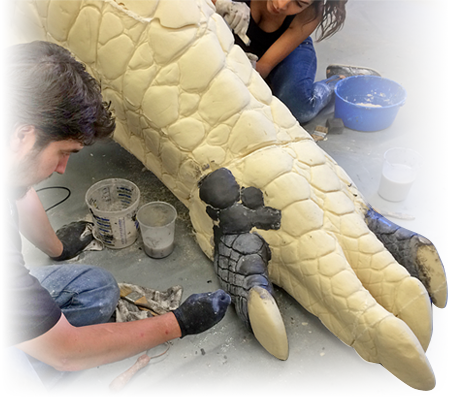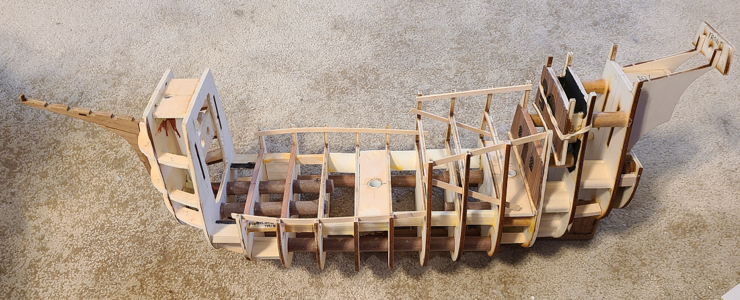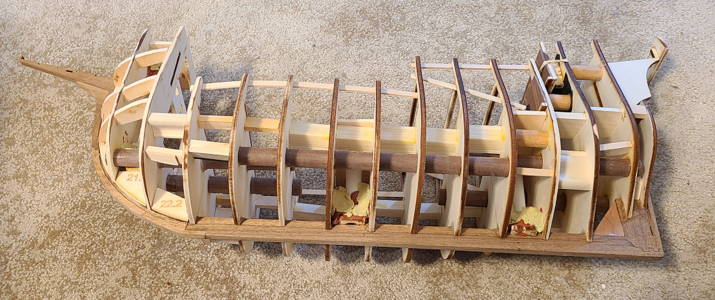I've decided to try the using Great Stuff expanding foam to fill in between the bulkheads. The main purpose is to strengthen the structure and provide a backing for additional glue to adhere when gluing planks in place. The secondary purpose is that it seems like a neat idea, and wanted to try it. This is against most advice I have been given, including my wife's who said if this destroyed my kit, I wasn't getting another one.
My intention is to glue the planks to the bulkheads and/or foam, using white glue if possible, CA glue on bulkheads only if necessary, or maybe even a combination of the two (CA on bulkheads, white glue on foam). After applying the foam between bulkheads, I will use a hot wire foam cutter, primarily, to remove the majority of foam extending from the bulkheads, and sand to a final contour. As with similar filling using balsa or other wood, it doesn't need to fill every gap, just provide as much support as reasonably possible.
Going in, I wasn't sure how much foam I would actually use; if it starts running everywhere and messing stuff up, I'll stop. I'll start small, especially in highly curved areas needing support more, and just see what happens.
I started by trying to protect any finished areas, or large areas into which I would prefer the foam not go. I /think/ I can remove the foam from anywhere, but it will be neater and take less time if it is mostly where I want it to be. So I need to protect everything, even though I may not get that far. I started with the area above the main deck. I first took a piece of cardboard and located along its length the location of the bulkheads:
Then I measured the inside width between inside of bulkheads, divided by 2, and marked that distance out from the edge of the cardboard. Then measured the extreme width, and did the same, and finally cut the piece to that outline.
The measured and cut cardboard fit like this:
I traced this outline for the other side, but rather than cutting out for the bulkheads, I just bent the tabs up, and put both into place:
I protected and glued into place the finished bulkhead 17, with doors, windows and planking, into place. I really don't want foam on any finished areas:
You may recall I inserted pieces of plastic tubing for the 3 major masts to fit into, but the bowsprit simply goes through 2 holes in 2 of the bulkheads. When foaming this critical bow area, the internal portion of the bowsprit is exposed to any foam or filler:
And yet, the bowsprit had to be in place when doing the foaming to allow it to be positioned correctly later (okay, I could have drilled through the foam, but didn't think of that then). To keep the foam from contacting the bowsprit and "gluing" it in place, I wrapped the end of the bowsprit in waxed paper and taped it in place:
Even though the waxed paper is loose, by rotating clockwise during insertion, it stays in place fine.
This fuzzy picture shows the various protections in place, to keep foam away from things I don't want it to touch, or just limit its migration:
The stern has been covered with tape as well. I used painters tape on areas which had been finished, and masking tape on areas that were not.
My intention was to do the foaming in the garage, where if it (or I) went wild, it would cause less damage (provided I kept it away from my wife's car, in which case I'd be moving out anyhow). But high temperatures today and in the near future are in the 50s F, and Great Stuff prefers closer to 75F. So I used a large trash bag to protect my desk, put on old clothes, and set up ready to foam away:
I began by foaming the bow area, around the bowsprit, which is most curved, knowing it needed the most support. My thought is to foam a little at a time, slowly, and stop if I ran into trouble (or preferably before it):
One thing that surprised me is that the foam did not expand as much as I thought it would. I tried to keep the foam more or less level with the bulkheads.
I didn't take any more photos until I was finished; I ran out of foam, actually, not quite filling areas along amidships as I had intended, but I noticed that the foam had continued to expand, especially at the bow:
An hour or two later, as I write this, I notice the foam is still expanding:
Looks like most areas will be filled when it's done.
I had intended to not post any of this until at least tomorrow, after which I would see the final effects of the foam to my model, and also show the removal of it, hopefully ending up with an excellent-looking result.
But - if I have to wait, so do you. I'm only posting the result to this point. I will discover the result tomorrow, and possibly/probably begin removal of excess foam then. So we will both find out, after tomorrow, whether I am continuing this build of a Ragusian Carrack, or if I have changed my goal to a 1/3 scale model of the Michelin Man. Fingers crossed, everyone, okay?










